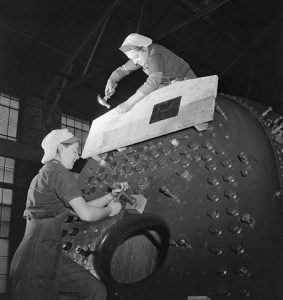Not a Hood Ornament

Women identified as the Davis sisters prepare a boiler of the X/Dominion locomotive for shipment during the Second World War.
Michelle’s Experience as a Woman in the Railways
When Michelle Ardron joined the Canadian Pacific Railway (CPR) in the late 1980s, CPR was looking to hire more women. Canadian National Railways (CN) had female locomotive engineers, but CPR did not. Women had worked for the railways since the Second World War. Despite this, Michelle faced some resistance when she started working. She understood that her supervisor was told to hire her, even if he did not want to. Some workers wanted to keep her as a “hood ornament” rather than let Michelle do any of the work required in her position. But Michelle worked hard, and she was accepted by her colleagues. Michelle recognized that she was in a unique situation, and something not experienced by some of her peers. Her team was mostly older men, around her father’s age. She thought they would not accept her. However, when she showed she could do the same work they could, they began to accept Michelle.
I Drive Trains Too (captions available in both French and English). Enjoy this video with an English transcript.
This journey was not without challenges. Michelle admits she has a bad back from throwing switches in the yard. She did not ask for help because she did not want to appear weak. She somewhat regrets this decision because it may not have been necessary. Many men cannot do the challenging work alone, and there is nothing wrong with asking for help.
Michelle knows that there were some comments made that she had to ignore to be accepted. You can hear Michelle talk about one of these instances in the video above. She also had to prove herself to be taken seriously, and that other workers assumed she did not have the same knowledge as they did. However, Michelle’s best experiences were in the locomotive cab. She had great conversations with her coworkers and thinks they opened up to her because she was a woman.
A Big Role in the History (captions available in both French and English). Enjoy this video with an English transcript.
Michelle believes there was a tokenization element to hiring women in the railways. It was challenging for her and her female colleagues to get promoted. Once a woman was hired, a box was checked for the companies. However, as you can hear Michelle explain in the video below, the railways are better when different people work together. It makes the company stronger, and better for everyone. When Michelle started, toilets in the locomotives consisted of plastic bags. As a safety inspector, she ensured locomotives should provide facilities for the operating crews. This type of change helps everyone working on the railways.

